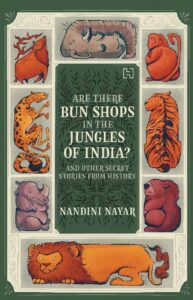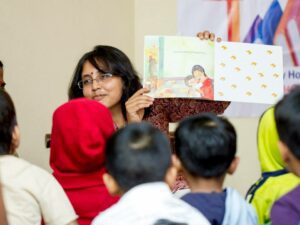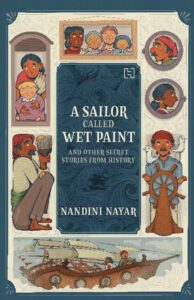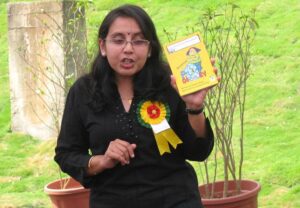Despite having written 70 books in 18 years, this award-winning children’s author doesn’t think she has 'arrived' as a writer and wants to keep publishing.

Nandini has authored 70 books in 18 years. (Supplied)
Food is a significant motif in Nandini Nayar’s books. For instance, her second book, What Shall I Make (2006), is a playful story about a son’s imagination and the satisfaction that comes from cooking with his mother.
Nandini believes that food is a subject everyone can bond over and this theme follows in almost all of her 70 books, written in 18 years!
“32 out of these are picture books,” the Hyderabad-based children’s author informs, “I also have over 300 short stories, published in various children’s magazines and newspapers.”
Her process of ideation is simple — don’t look for story ideas, let them come to you! “When you aren’t actively seeking ideas, that’s when they strike,” she says with a smile. “Many of my ideas come to me when I am cooking.”
Last month, she released two books (published by Hachette India) — Are There Bun Shops in the Jungles of India and Other Secret Stories from History and A Sailor Called Wet Paint and Other Secret Stories from History.

Cover of Are There Bun Shops in the Jungles of India and Other Secret Stories from History. (Supplied)
“Both are collections of stories,” she quickly adds, “…both are based on intensive research.”
Peppered with photos, the books have special pages with historical nuggets — fascinating enough to keep children hooked.
“During the British colonial period in India, many wild animals were trapped and transported,” Nandini begins. “These animals were displayed in menageries and later, zoos. I was determined to find out more about these animals but there is no documentation of how they were taken to England, how they were captured, and where. However, I persisted because I felt these were stories that needed to be told.”
It was in the course of this research that Nandini stumbled upon stories of “travellers” to England.
“These were sailors (lascars) and ayahs and other servants that the English took back to England with them. Again, there were no written records of their experiences since these people were usually unlettered. So, I sifted through travel accounts and diaries to find mentions of these people,” she says.
Nandini intrigues her readers with many such historical facts in her two new books.

Nandini Nayar during a book reading session. (Supplied)
Born in Jabalpur to Maharashtrian parents, Nayar grew up in Chennai and studied in Mysuru and Hyderabad. Needless to say, different people, languages, and cultures have had an impact on her.
Chennai city, in particular, introduced her to reading at a very early age.
“My parents encouraged this interest by subscribing to magazines like Champak and Target, and getting me and my brother a membership at a local lending library,” she shares.
“There was also a brisk borrowing-lending system among the children who lived in the colony. So, if one person found or borrowed or even bought a book, it made its round among all the other children in the colony.”
Nandini turned out to be the only writer in her extended family. “Why, some of them don’t even read,” she points out.

Cover of A Sailor called WET PAINT and Other Secret Stories from History. (Supplied)
Her first book was published in 2005 by Tulika and was titled Pranav’s Picture. “But my writing journey began a few years before that when a short story was published in the children’s pages of a newspaper,” she recalls.
“The publishing of the story made me realise that I could fulfil my dream of being a writer. After that, it was a matter of writing regularly and sending stories off to various publishers.”
She was rejected multiple times but continued writing and publishing. Today, she is one of the most prolific children’s writers in the country.
But her first two books, Pranav’s Picture and What Shall I Make, remain her favourites.
“Every book is special for a reason,” she continues. “For instance, the four books about Apoorva (Apoorva’s Fat Diary, Meanie.com, Dear Aunty, and Laugh Out Loud, Apoorva) are very close to my heart because of all the things I got to write about here,” she says.
Apoorva’s Fat Diary, the first book in this four-part series, is about a plump girl and is widely appreciated for tackling the issue of body shaming. The book won the Best of Indian Children’s Writing (BICW) award in 2019.
When Nandini was growing up, the most famous author was Enid Blyton. “Like everyone else, I read her books too,” she confesses. “But I was adventurous and always looking for new authors. I discovered authors like Malcolm Saville and the books Agatha Christie wrote under a pseudonym.”
Nandini’s favourite authors today are very different from the books she enjoyed in her childhood. “A lot of the books that one considers favourites as a child don’t always stay loved once you are older,” she explains. “Oh, you still enjoy reading them, but it’s like visiting a favourite memory to try and capture something of childhood’s innocence and carefree freedom.”

Nandini with Apoorva’s Fat Diary. (Supplied)
Currently, she enjoys books by Subhadra Sen Gupta, Ranjit Lal’s The Battle for No 19, and books by Shashi Deshpande. “Diana Wynne Jones, Neil Gaiman, Amitav Ghosh, and Stephen King are other authors I enjoy,” she shares.
When Nandini ventured into storytelling two decades ago, only Western titles were doing well in the children’s publishing market, except books by just a couple of coveted Indian authors.
Today, there are over a dozen festivals across the country celebrating children’s books.
“In those days, there were no book launches for children’s books, no children’s literature festivals, or social media to draw attention to a new release,” she remembers.
“It is only now when social media allows readers to connect with the creators of their favourite books, that I truly understand the reach of my books and the kinds of people whose lives they have touched,” she says.
Nandini recalls one incident that reserved a special place in her heart. “I was at a literature festival in a school I was supposed to do storytelling and a little girl in the front row informed me that she didn’t like stories. She said they were boring. I asked her to give me a chance and she agreed. At the end of my session, she told me that she had changed her mind — stories were not boring and that she was going to tell everyone so!” she recalls.
Nandini is on a roll and is set to release two more books soon. “One is a board book about Ganesh Chaturthi, and the other is a book for newly-independent readers.”
She still doesn’t think of herself as having “arrived”. “My journey as a writer is a continuous one and I am happy to be writing,” she concludes.
You can follow Nandini Nayar on Instagram here.

Jul 26, 2024

Jul 26, 2024

Jul 26, 2024

Jul 25, 2024

Jul 25, 2024

Jul 25, 2024